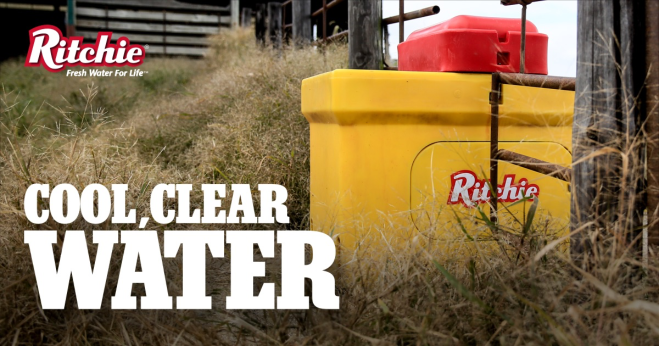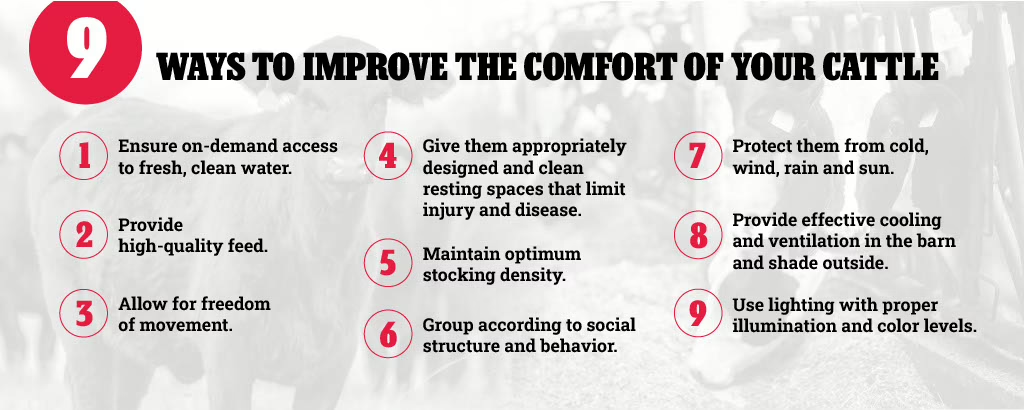COW COMFORT IS KEY TO ANIMAL WELFARE AND PRODUCTIVITY
Consumers are increasingly interested in how their food is produced. They want to know who produces it, how animals are cared for and the impact on the environment. In a survey of 1,000 American consumers, 70% of respondents reported paying attention to labels that indicate how the animals were raised and 78% believed there should be an objective third party to ensure farm animal welfare.1
A 2020 dairy consumer survey revealed that almost half of the respondents would purchase more products from companies that make animal welfare a core part of their business philosophy, and about three-quarters would pay a premium for these products.2
Dairy farmers have been proactive in this area, with more than 99% of the U.S. milk supply coming from farms that participate in the National Dairy Farmers Assuring Responsible Management (FARM) Program.3 One of FARM’s highest priorities is animal care. Ensuring cow comfort has become a top priority at many dairy farms, and beef producers are following suit.
How does cow comfort affect dairy and beef production?
Cow comfort isn’t just a consumer preference, either. Comfort is important to the overall health and well-being of cows, and that affects reproductive efficiency as well as milk production and beef gain.
Effects on dairy productivity
One study on cow comfort revealed that improved cow comfort can lead to greater milk yield, with increases ranging from 3 to 14 pounds per cow per day.4
Effects on beef productivity
According to Iowa State University Extension and Outreach Beef Specialist Beth Doran, comfortable cattle perform better and, consequently, are more profitable. And comfortable, stress-free cattle result in beef that’s more tender and juicy, important qualities for consumer satisfaction.5 Ensuring cow comfort by providing shade and limiting feeding during heat stress conditions led to a 7% increase in daily gains and a 4% improvement in feed-to-gain efficiency.6
Effects on calves
Researchers have also proven that a healthy start to life has positive effects on a calf’s entire life from pasture to plate. And that’s related to cow comfort. For example, anything producers can do to keep a calf warm and dry at the beginning of life can help improve its colostrum intake and its ability to absorb immunoglobulins within the first 24 hours, setting it up to thrive.7
How can I improve cow comfort on my operation?
Here are nine ways to improve the comfort of your cattle:
- Ensure on-demand access to fresh, clean water.
- Provide high-quality feed.
- Allow for freedom of movement.
- Give them appropriately designed and clean resting spaces that limit injury and disease.
- Maintain optimum stocking density.
- Group according to social structure and behavior.
- Protect them from cold, wind, rain and sun.
- Provide effective cooling and ventilation in the barn and shade outside.
- Use lighting with proper illumination and color levels.
Hydration is key to cow comfort
Hydration plays a big role in keeping cows comfortable and healthy. Water helps them regulate body temperature, improves feed intake and digestive function, and contributes to a stronger immune system. And it’s crucial to productivity.
Milking cows drink between 30 to 50 gallons of water per day to produce nutrient-packed milk. For beef cattle, water intake is positively correlated with average daily gain and feed intake.8 According to University of Nebraska-Lincoln publications, beef cattle need about 1 gallon of water per day for every 100 pounds of body weight, given average production conditions.9
“I always tell my clients that water is the most essential nutrient because without access to good, clean, fresh water you will limit the animal’s ability to perform,” said Dr. King Hickman, D.V.M., and founding partner of GPS Dairy Consulting in Sheldon, Iowa. “You want to make sure that you are testing the water periodically to make sure it’s not high in sulfates, nitrates, manganese or iron to ensure good water quality. Another issue I see most commonly is not providing enough water space for the size and capacity of the pens, and the waterers may be undersized. A simple rule of thumb is to plan for two linear inches of water space per lactating cow. You need to have enough space around your water troughs so that the animals can get a drink while other animals can still pass through and the area doesn’t become a bottleneck.”
“Waterers that don’t perform well, meaning they aren’t filling quick enough, can negatively impact milk production,” said Dr. Hickman. “You need enough water pressure and enough flow to meet the water demands of your cattle. Think about a water fountain that you or I might drink from where the water just barely dribbles out and you have a hard time getting enough water at one time. Or think about a water fountain that has too much pressure and the water just shoots out of the bowl. The availability of enough water for your animals is crucial to prevent subclinical dehydration in dairy cattle.”
Choose automatic waterers that contribute to well-being
Concrete and polyurethane waterers (with or without stainless steel troughs) are the two main types of waterers on the market. You can find options that include insulation, heating elements and constant flow valves.
“Whether you are looking to install new construction or upgrade your waterers, it is important to consider how they fit into the overall facility design and how that impacts the comfort of the cows,” said Ritchie Industries Sales and Marketing Manager Jeff Miller. “Compare how fast they refill, how durable the units are, maintenance requirements, warranty coverage, and how easy they are to clean. For over 100 years, Ritchie has been made in America, and we produce the fastest energy efficient founts in the industry. We have expertly engineered valves to serve any water pressure environment, and your cows won’t be able to outdrink a Ritchie,” he added.
“Every single Ritchie fount meets all Grade A dairy requirements, and our entire product lineup has been designed with animal safety and comfort in mind. All our stainless-steel troughs have hemmed and smooth edges and our poly units have smooth, curved surfaces. Our poly units are also 75% more efficient than comparable concrete units and they won’t pit. Plus, we offer several models that may qualify for utility incentives in numerous states. It all adds up to a more efficient, clean and comfortable drinking environment,” said Miller.
The bottom line: A comfortable cow is a productive cow
Cow comfort is key to raising healthy and happy cows that rest, exercise, eat and drink at a level to optimize production. Operations that prioritize cow comfort pay attention to every little detail, and that pays big dividends. Take steps to improve your cows’ comfort and see the benefits to their well-being and your operation’s profitability.
References
1 Spain, C. V., Freund, D., Mohan-Gibbons, H., Meadow, R. G., & Beacham, L. (2018, July 25). Are they buying it? United States consumers’ changing attitudes toward more humanely raised meat, eggs, and dairy. MDPI. https://www.mdpi.com/2076-2615/8/8/128
2 Adams, C., Lieberman, M., Maluf, I., & Paula, R. U. de. (2021, May 12). How the COVID-19 pandemic has changed dairy preferences among us consumers. McKinsey & Company. https://www.mckinsey.com/industries/agriculture/our-insights/how-the-covid-19-pandemic-has-changed-dairy-preferences-among-us-consumers
3 Animal care. National Dairy FARM Program. (2024, September 4). https://nationaldairyfarm.com/dairy-farm-standards/animal-care/
4 Cook, N.B. 2006. Extreme makeover: Freestall edition. Proc. of the VitaPlus Dairy Summit, Lansing, MI.
5 Doran, B. (n.d.). Comfortable cattle provide better quality beef, more profit. News. https://www.extension.iastate.edu/news/comfortable-cattle-provide-better-quality-beef-more-profit
6 DeBord, Z., Blasi, D., & Tarpoff, A. J. (2023, June). The effect of shade and limit feeding on cattle comfort, water consumption, and efficiency during the receiving and backgrounding phase. Beef Research. https://www.beefresearch.org/resources/beef-sustainability/project-summaries/sustainability-project-summaries-by-category/environmental-sustainability-summaries/the-effect-of-shade-and-limit-feeding-on-cattle-comfort-water-co
7 Catering to cattle comfort pays off in performance. https://hereford.org/static/files/0212_Comfort_Performance.pdf
8 Holter, J. B., et al. (2011, April 20). Water intake and factors affecting water intake of growing beef cattle. Livestock Science.https://www.sciencedirect.com/science/article/abs/pii/S1871141311001375#:~:text=Consumption%20averaged%2029.98%20%C2%B1%208.56,no%20relationship%20to%20feed%20efficiency.
9 Harrison Dudley. (2017, August). Water for beef cattle. NC State Extension News. https://beef.ces.ncsu.edu/water-for-beef cattle/#:~:text=University%20of%20Nebraska%2DLincoln%20publications,gallons%20of%20water%20a%20day.

